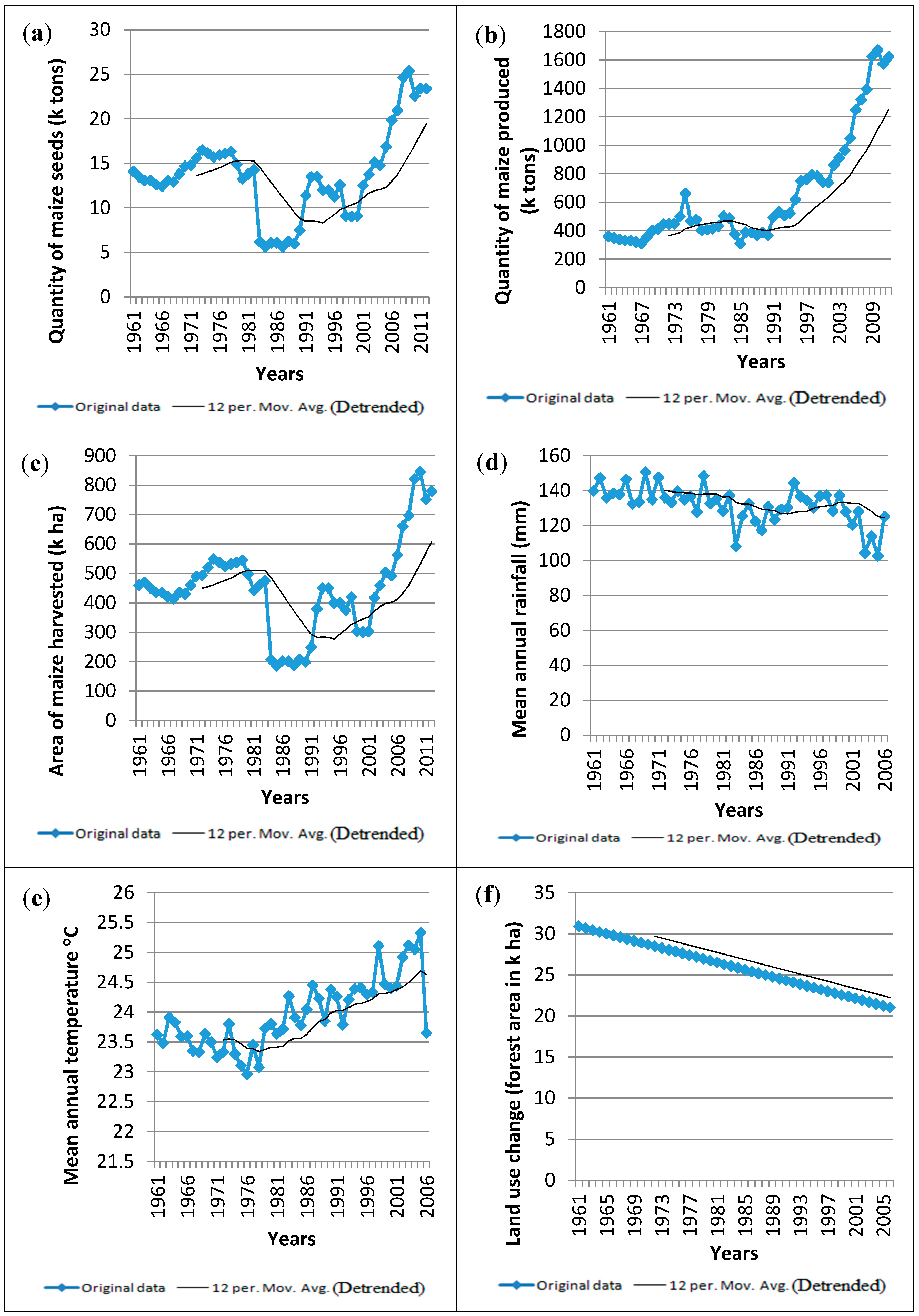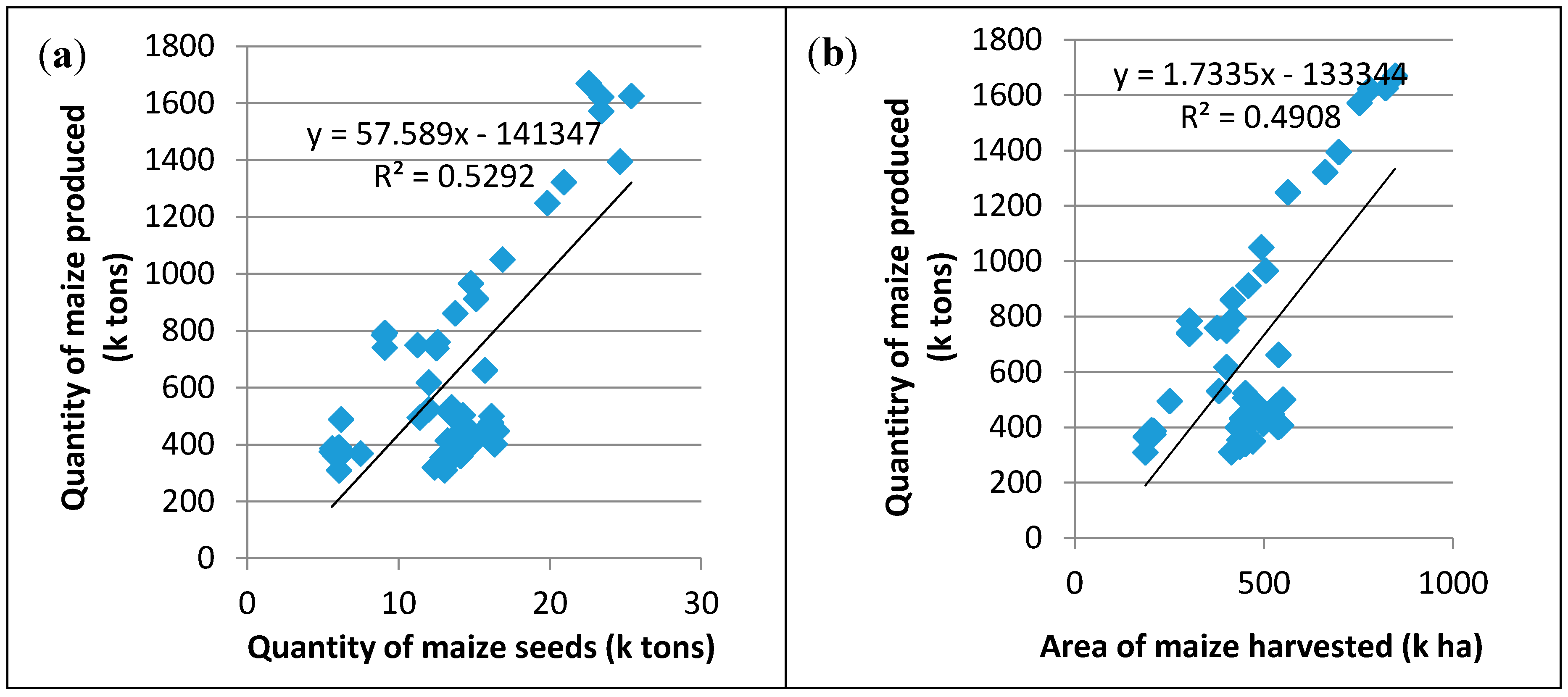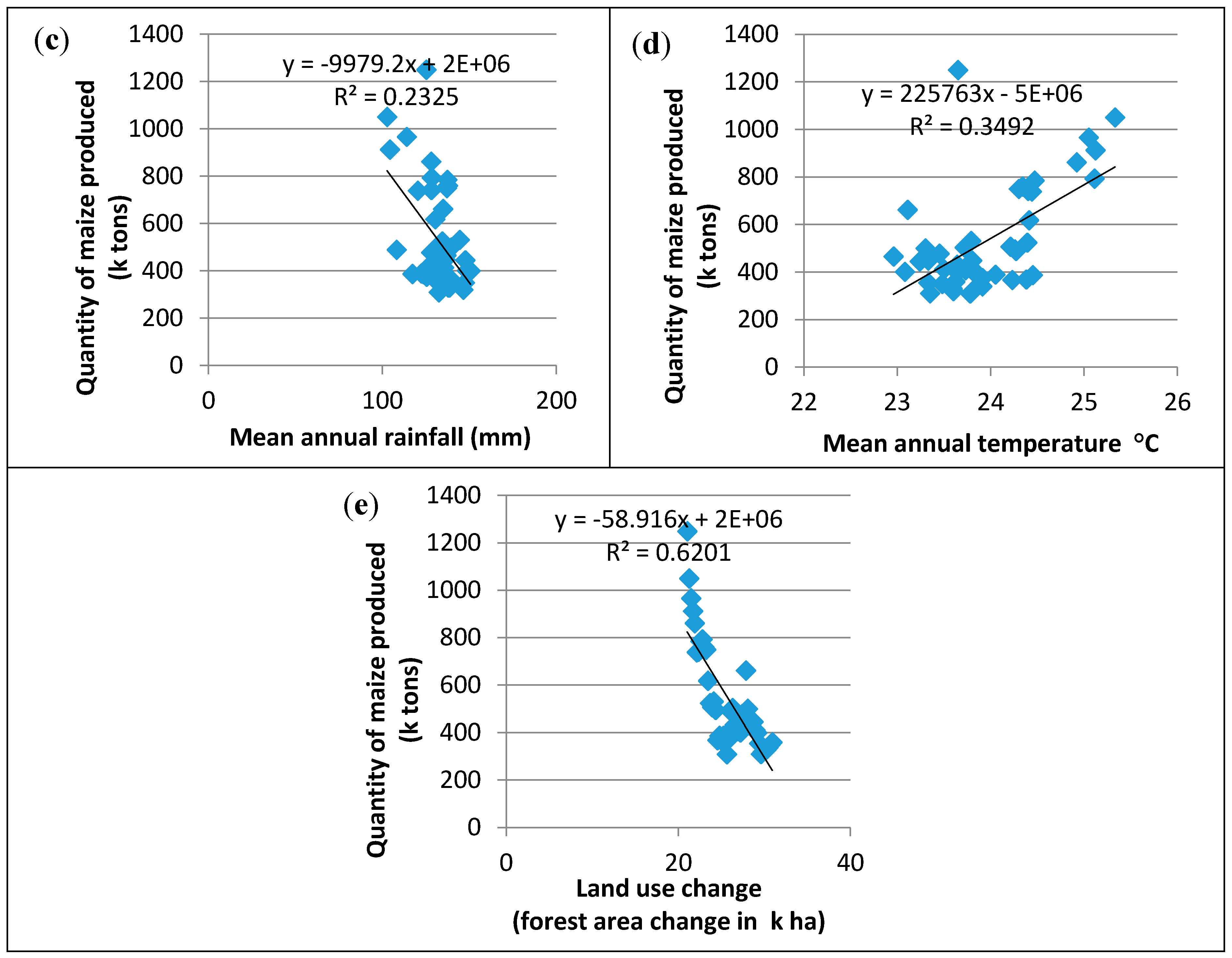Maize Production Responsiveness to Land Use Change and Climate Trends in Cameroon
Abstract
:1. Introduction
2. Methods
2.1. Data Acquisition
2.2. Data Analysis
3. Results
3.1. Trend analysis and Detrended Data Simulations of the Variables under Consideration

3.2. Assessing the Responsiveness of Maize Production to Rainfall, Temperature and Forest Area Change
| Variables | Area of Maize Harvested | Quantity of Maize Produced | Quantity of Seeds Produced | Mean Annual Rainfall (mm) | Mean Annual Temperature °C | Land Use Change (Forest Area in k ha) |
|---|---|---|---|---|---|---|
| Area of maize harvested | 1 | |||||
| Quantity of maize produced | 0.22 | 1 | ||||
| Quantity of seeds produced | 0.86 | 0.32 | 1 | |||
| Mean annual growing season rainfall (mm) | 0.18 | −0.48 | 0.22 | 1 | ||
| Mean annual growing season temperature (°C) | −0.31 | 0.59 | −0.30 | −0.65 | 1 | |
| Land use change (forest area in k ha) | 0.26 | −0.78 | 0.16 | 0.58 | −0.76 | 1 |
| Coefficients | Standard Error | t-Stat | p-Value | |
|---|---|---|---|---|
| Area of maize harvested (ha) | 0.37 | 0.25 | 1.44 | 0.15 |
| Quantity of maize seeds (tons) | 20.63 | 8.17 | 2.52 | 5.72 |
| Rainfall (mm) | −1497.11 | 1721.03 | −0.86 | 0.38 |
| Temperature (°C) | 47,710.87 | 41,147.57 | 1.15 | 0.25 |
| Land use change (Forest area in k ha) | −56.38 | 7.64 | −7.37 | 0.01 |


4. Discussion
5. Conclusions
Supplementary Materials
Acknowledgments
Author Contributions
Conflicts of Interest
References
- Kulcharik, C.J.; Serbin, S. Impacts of recent climate change on Wisconsin corn and soyabean yiled trends. Environ. Res. Lett. 2008. [Google Scholar] [CrossRef]
- Duvick, D.N.; Cassman, K.G. Post-green revolution trends in yield potential of temperate maize in North-Central United States. Crop Sci. 1999, 39, 1622–1630. [Google Scholar] [CrossRef]
- Ramankutty, N.; Foley, J.A.; Norman, J.; McSweeney, C. The global distribution of cultivable lands: Current patterns and sensitivity to possible climate change. Glob. Ecol. Biogeochem. 2002, 11, 377–392. [Google Scholar] [CrossRef]
- Peng, S.; Huang, J.; Sheehy, J.E.; Laza, R.C.; Visperas, R.C.; Zhong, X.; Centeno, G.S.; Khush, G.S.; Cassman, K.G. Rice yields decline with higher night temperature from global warming. Proc. Natl. Acad. Sci. USA 2004, 101, 9971–9975. [Google Scholar] [CrossRef] [PubMed]
- Tao, F.; Yokozama, M.; Xu, Y.; Hayashi, Y.; Zhang, Z. Climate changes trends in phenology yields of field crops in China 1981–2000. Agric. For. Meteorol. 2006, 138, 82–92. [Google Scholar] [CrossRef]
- Auffhammer, M. Weather dilemma for African maize. Nat. Clim. Chang. 2011. [Google Scholar] [CrossRef]
- Lobell, D.B.; Burke, M.B.; Tebaldi, C.; Mastrandrea, M.D.; Falcon, W.P.; Naylor, R.L. Prioritizing climate change adaptation needs for food security in 2030. Science 2008, 319, 607–610. [Google Scholar]
- Lobell, D.B.; Banziger, M.; Magorokosho, C.; Vivek, B. Nonlinear heat effects on African maize as evidenced by historical yield trials. Nat. Clim. Chang. 2011, 1, 42–45. [Google Scholar] [CrossRef]
- Lobell, D.B.; Field, C. Global scale climate-crop yield relationships and the impacts of recent warming. Environ. Res. Lett. 2007, 2, 014002. [Google Scholar] [CrossRef]
- Shi, W.; Tao, F. Vulnerability of African maize yield to climate change and variability during 1961–2010. Food Secur. 2014, 6, 471–481. [Google Scholar] [CrossRef]
- Tingem, M.; Rivington, M.; Colls, J. Climate variability and maize production in Cameroon: Simulating the effects of extreme dry and wet years. Singap. J. Trop. Geogr. 2008, 29, 357–370. [Google Scholar] [CrossRef]
- Intergovernmental Panel on Climate Change (IPCC). The Regional Impacts of Climate Change: An Assessment of Vulnerability. Available online: http://www.ipcc.ch (accessed on 12 August 2014).
- Jones, P.G.; Thornton, P.K. The potential impacts of climate change on maize production in Africa and Latin America in 2055. Glob. Environ. Chang. 2003, 13, 51–59. [Google Scholar]
- Molua, E.L. Climate trends in Cameroon: Implications for agricultural management. Clim. Res. 2006, 30, 255–262. [Google Scholar] [CrossRef]
- FAO. Food and Agricultural Organization of the United Nations (FAO) FAO Statistical Databases. FAOSTAT 2014. Available online: http://www.faostat.org (accessed on 12 August 2014).
- Lambin, E.F.; Geist, H.; Lepers, E. Dynamics of land use and land cover change in tropical regions. Annu. Rev. Environ. Resour. 2003, 28, 205–241. [Google Scholar] [CrossRef]
- McSweeney, C.; New, M.; Lizcano, G. UNDP Climate Change Country profiles: Cameroon. Available online: http://country-profiles.geog.ox.ac.uk (accessed on 15 May 2014).
- McSweeney, C.; New, M.; Lizcano, G.; Lu, X. The UNDP Climate Change Country Profiles Improving the Accessibility of Observed and Projected Climate Information for Studies of Climate Change in Developing Countries. Bull. Am. Meteorol. Soc. 2010, 91, 157–166. [Google Scholar] [CrossRef]
- Sacks, W.J.; Deryng, D.; Foley, J.A.; RamanKutty, N. Crop production dates: Analysis of global patterns. Glob. Ecol. Biogeogr. 2010, 19, 607–620. [Google Scholar]
- FAO. World Agriculture: Towards 2030/2050. Interim Report 2006; FAO: Rome, Italy, 2006. [Google Scholar]
- FAO. Global Forest Resources Assessment (GFRA). Main Report. Available online: http://foris.fao.org/static/data/fra2010/FRA2010_Report_1oct2010.pdf (accessed on 20 May 2014).
- Hulme, M. Climatic perspective on Sahelian desiccation: 1973–1998. Glob. Environ. Chang. 2001, 11, 19–29. [Google Scholar] [CrossRef]
- Olsson, L.; Mryka, H. Greening of the Sahel. The Encyclopedia of the Earth 2008. Available online: http://www.eoearth.org/article/Greening_of_the_Sahel (accessed on 12 July 2014).
- Eklundh, L.; Olsson, L. Vegetation index trends for the African Sahel 1982–1999. Geophys. Res. Lett. 2003, 30. [Google Scholar] [CrossRef]
- Epule, E.T.; Changhui, P.; Laurent, L.; Zhi, C. Rainfall and deforestation dilemma for cereal production in the Sudano-Sahel of Cameroon. J. Agric. Sci. 2012. [Google Scholar] [CrossRef]
- Anyamba, A.; Tucker, C.J. Analysis of Sahelian vegetation dynamics using NOAA-AVHRR NDVI data from 1981–2003. J. Arid Environ. 2005, 63, 595–614. [Google Scholar] [CrossRef]
- Schlenker, W.; Lobell, D.B. Robust negative impacts of climate change African agriculture. Environ. Res. Lett. 2010, 5, 014010. [Google Scholar] [CrossRef]
- Zeng, N. Droughts in the Sahel. Science 2003, 302, 999–1000. [Google Scholar] [CrossRef] [PubMed]
- Clover, J. Food security in sub-Saharan Africa. Afr. Food Rev. 2010, 1, 5–15. [Google Scholar]
- Fuller, D.O.; Ottke, C. Land cover, Rainfall and Land-Surface Albedo in West Africa. Clim. Chang. 2002, 54, 181–204. [Google Scholar] [CrossRef]
- Lobell, D.B.; Schlenker, W.; Costa-Roberts, J. Climate trends and global crop production since 1980. Science 2011, 333, 616–620. [Google Scholar] [CrossRef]
- Shi, W.; Tao, F.; Lui, J.; Xu, X.; Kuang, W.; Dong, J.; Shi, X. Has Climate Change Driven Spatio-temporal Changes of Cropland in Northern China since the 1970s? Clim. Chang. 2014, 124, 163–177. [Google Scholar] [CrossRef]
- Shi, W.; Tao, F. Spatio-temporal Distributions of Climate Disasters and the Response of Wheat Yields in China from 1983 to 2008. Nat. Hazards 2014, 74, 569–583. [Google Scholar] [CrossRef]
- Shi, W.; Tao, F.; Lui, J. Changes in quantity and quality of cropland and the implications for grain production in the Huang-Huai-Hai Plain of China. Food Secur. 2013, 5, 69–82. [Google Scholar] [CrossRef]
- Epule, T.E.; Peng, C.; Lepage, L.; Chen, Z. The causes, effects and challenges of Sahelian droughts: A critical review. Reg. Environ. Chang. 2014, 4, 145–156. [Google Scholar] [CrossRef]
- Shi, W.; Tao, F. A Review on Statistical Models for Identifying Climate Contributions to Crop Yields. J. Geogr. Sci. 2013, 23, 567–576. [Google Scholar] [CrossRef]
- Roudier, P.; Sultan, B.; Quirion, P.; Berg, A. The impact of future climate change on West African crop yields: What does the recent literature say? Glob. Environ. Chang. 2011, 21, 1073–1083. [Google Scholar] [CrossRef]
- Bele, M.Y.; Tiani, A.M.; Somorin, O.A.; Sonwa, D.J. Exploring vulnerability and adaptation to climate change of communities in the forest zone of Cameroon. Clim. Chang. 2013, 119, 875–889. [Google Scholar] [CrossRef]
- Cairns, J.E.; Sonder, K.; Zaidi, P.H.; Verhulst, N.; Mahuku, G.; Babu, R.; Nair, S.; Das, B.; Govaerts, M.T.; Vinayan, T.M.; et al. Maize Production in a Changing Climate: Impacts, Adaptation, and Mitigation Strategies. Adv. Agron. 2012, 114, 1–58. [Google Scholar]
- Prince, S.D.; Brown, E.; Kravitz, L.L. Evidence from rain-use efficiencies does not indicate extensive Sahelian desertification. Glob. Chang. Biol. 1996, 4, 359–374. [Google Scholar] [CrossRef]
- Epule, T.E.; Peng, C.; Lepage, L.; Nguh, B.S.; Mafany, N.M. Can the African food supply model learn from the Asian food supply model? Quantification with statistical methods. Environ. Dev. Sustain. 2012, 14, 593–610. [Google Scholar] [CrossRef]
© 2014 by the authors; licensee MDPI, Basel, Switzerland. This article is an open access article distributed under the terms and conditions of the Creative Commons Attribution license (http://creativecommons.org/licenses/by/4.0/).
Share and Cite
Epule, T.E.; Bryant, C.R. Maize Production Responsiveness to Land Use Change and Climate Trends in Cameroon. Sustainability 2015, 7, 384-397. https://doi.org/10.3390/su7010384
Epule TE, Bryant CR. Maize Production Responsiveness to Land Use Change and Climate Trends in Cameroon. Sustainability. 2015; 7(1):384-397. https://doi.org/10.3390/su7010384
Chicago/Turabian StyleEpule, Terence Epule, and Christopher Robin Bryant. 2015. "Maize Production Responsiveness to Land Use Change and Climate Trends in Cameroon" Sustainability 7, no. 1: 384-397. https://doi.org/10.3390/su7010384





